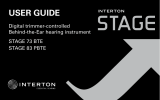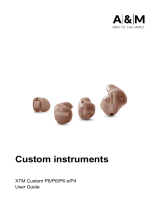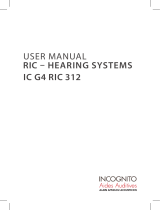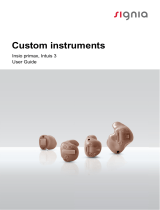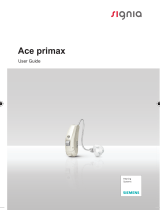Page is loading ...

User Guide
Receiver-In-Ear (RIE) Models:
Interton Cosmo
Interton Crisp

23
Programme Beep Description of when to use
1
2
3
4
Delayed on-activation...............12
Multi-Function button ...............20
Push button......................22
Wireless................15, 23, 24, 42
AutoPhone.......................27
Telecoil/Tele-loop system ............31
Direct Audio Input (DAI)..............32
SPECIFIC FEATURES SUPPORTED BY YOUR HEARING SYSTEM:
Note: Your hearing system might not support all 4 environmental programmes. Ask your hearing care professional for details.
Ask your hearing care professional to marked options supported by your hearing system.
Left Hearing Instrument Right Hearing Instrument
Serial number Serial number
Receiver type Normal Power
High Power
Receiver type Normal Power
High Power
Reciever size Reciever size
Batteri size 312 brown
Open/
standard
fitting:
Open fitting air dome Power dome RIE mould
Small Medium Large St dome Small Medium Large Custom

45
Becoming Accustomed to Amplification
While purchasing a hearing system is a major step, it is only one step in a process toward more comfortable
hearing. Successfully adapting to the amplification your hearing system provides takes time and consistent
use.
You will enjoy more benefits from your Interton hearing system by taking the following actions:
• Wear the system regularly in order to get comfortable with using it.
• It takes time to get used to a hearing aid. It may help to begin by wearing your hearing aid for short
periods – even as little as 15 minutes – and then gradually building up your wearing time. In a way, it’s
no different than adjusting to contact lenses. Speak to you hearing care professional, who can design
a schedule tailored just for you.
• As you get more comfortable with the system, increase the wearing time and wear your hearing system
in multiple types of listening environments.
It may take as long as several months for your brain to get used to all the “new” sounds around you. Fol-
lowing these suggestions will give your brain time to learn how to interpret amplification and increase the
benefits you get from using an Interton hearing system.
Thank You
Thank you for selecting an Interton hearing system. We are proud of our hearing products and are confi-
dent you have chosen one of the best products available.
Please familiarize yourself with the information in this guide. It contains important instructions for proper
use and care, technical performance information, and other general information about your hearing system.
Your hearing system has been adjusted to your particular hearing loss. Your hearing health care professional
will explain these adjustments and the special features of your particular model.
All the key features and functions of your hearing system are explained in
video tutorials. To watch them simply scan QR codes and watch the videos
on your smartphone. If you do not have scanning application installed yet you
can go to getscanlife.com on your mobile browser to download free applica-
tion. (ScanLife® is one of the free applications you can use to play QR codes,
you can also use any other QR scanner to play the videos).

67
Intended use
Generic air-conduction hearing instruments are wearable sound-amplifying devices intended to compen-
sate for impaired hearing. The fundamental operating principle of hearing instruments is to receive, amplify,
and transfer sound to the ear drum of a hearing impaired person.
List of countries:
Products without wireless functionality are intended for worldwide sales.
Products with wireless functionality are intended for sale in countries within the European Economic Area
as well as Switzerland.
Specification of restrictions: You are not allowed to operate the equipment within 20 km of the centre of
Ny Ålesund, Norway.
The products are in compliance with the following regulatory requirements:
• In the EU: The device conforms to the Essential Requirements according to Annex I of Council Direc-
tive 93/42/EEC for medical devices (MDD) and Essential Requirements and other relevant provisions
of Directive 1999/5/EC (R&TTE). The declaration of conformity may be consulted at www.interton.com
• Other identified applicable international regulatory requirements in countries outside the EU. Please
refer to local country requirements for these areas.
• Products are categorized as class 2 receivers according to EN 300 440

89
Direct Audio input (optional) ...............32
Connecting/Disconnecting audio boots ......32
Care and maintenance...................33
Cleaning the reciever tubes and domes ......36
Cleaning RIE moulds ....................36
Cleaning wax guard ..................3 7, 3 6
How to apply domes ....................40
Mini domes ...........................40
Standard domes .......................41
Wireless warnings and precautions
(wireless devices only) ...................42
General warnings.......................43
Troubleshooting guide ...................46
Technical Data .........................54
Warranty and repairs ....................56
Temperature test, transport and
storage information......................57
Hearing instrument(s) model and basic information
2,3
Thank you .............................4
Becoming Accustomed to Amplification .......5
Intended use ...........................6
List of contries ..........................6
Instruments component identification ........10
On/ Off function........................12
Delayed activation (optional) ...............12
Inserting/ Replacing the battery ............13
Low battery indicator .....................5
Inserting/removing hearing instruments.......16
Multi function button (optional) .............20
Push button (optional) ...................22
Flight mode (wireless devices only)..........24
Telephone use ........................25
Listen to radio or TV ....................26
Cellular phones ........................26
AutoPhone (optional) ....................27
Telecoil (optional) .......................31
Tele-loop systems (optional) ...............31
CONTENTS

7
9
1
8
2
4
3
14
13
6
10 11
11. NP receiver tube
12. HP receiver tube
13. Left/right indicator
14. Model, and serial number
15. Direct Audio Input
1. Receiver tube
2. Receiver Open Dome
3. Receiver Tulip Dome
4. Receiver Power Dome
5. RIE mould
6. Sports lock
7. Battery compartment
8. Receiver
9. Push button
10. Multi-Function button
10
1
8
2
7
14
15
13
5
10 11
Hearing instruments of type SY312 are avail-
able in the following variants:
C661-DRW
C461-DRW
Hearing instruments of type MRIE are avail-
able in the following variants:
CI360-DVIRW

12 13
on just prior to placing them on your ear, your hearing care professional can activate a function called
Delayed on-activation. This function will delay the time in which the hearing instruments turn on by several
seconds after the battery compartment is closed. With Delayed on-activation, a beep will be heard for each
second of the delay period.
Inserting/Replacing the battery
1. Open the battery door completely by using your
fingernail.
2. Remove the used battery if present. Insert the new
battery with the positive side in the correct position.
3. Gently close the battery door.
i Always use new Zinc-Air batteries that have a minimum remaining shelf-life
of 1 year.
Getting started
On&Off function
1. When the battery door is closed, the hearing
instrument turns on, and the default program will
be activ ated.
2. To turn off the hearing instrument, open
the battery door. Many individuals can use their
fingernail to pull it open.
i Whenever the hearing instruments are not in use, remember to turn them off
to avoid unnecessary battery consumption.
Delayed activation
Hearing instruments can be turned on once you have placed them on your ears. If you prefer to turn them
Scan a QR code with your
smart phone and watch a
instruction video.
Scan a QR code with your
smart phone and watch a
instruction video.
On
Off

14 15
Low battery indicator
Your hearing care professional can set your hearing instrument to give an acoustical indication when the
battery is reaching its end of life. The hearing instrument will reduce amplification and emit a melody if bat-
tery power gets too low. This signal will recur every five minutes until the hearing instrument automatically
switches off. It is recommended that you keep spare batteries on hand.
Low battery indicator (instruments paired with accessories only)
Active usage of the Interton wireless accessories (Remote Control, Phone Clip and TV Streamer) requires
more battery power from the hearing instruments than when these are working on their own. When the
battery in the hearing instrument has depleted to a level at which use of the Interton TV Streamer TV and
Phone Clip cannot be supported, the hearing instrument will play two sets of descending tones. After
this, your hearing instrument and Interton Remote Control will continue to work as usual, but you will not
be able to use your Interton TV Streamer and Phone Clip. At some point the battery level will not support
the remote control either and you will once again hear the descending tones. The hearing instruments will
continue to work as usual. Once a new battery is inserted, full operation of the accessories will resume.
i WARNING
1. Remove the batteries to prevent leakage when the hearing instruments are not in use for an extended
period of time.
2. Do not attempt to recharge batteries (Zinc Air) which are not specifically designated as rechargeable
because they may leak or explode.
3. Do not place batteries in your mouth. Consult a physician immediately if a battery has been swallowed,
as they can be harmful to your health.
4. Keep batteries away from pets, children and individuals who are mentally challenged.
5. Do not attempt to dispose of batteries by burning them. Used batteries are harmful to the environment.
Please dispose of them according to local regulations or return them to your hearing care practitioner.

16 17
By experimenting, an easier method may be discovered. With proper insertion, hearing
instruments should fit snugly but comfortably. If the hearing instruments cause irritation of
the ears, contact your hearing care professional.
i CAUTION
Never attempt to modify the shape of the hearing instrument, earmoulds, or tubing your-
self.
i It may be helpful to pull your ear up and outward with your opposite hand during
insertion.
Sports lock
Sports lock will be applied or adjusted by your hearing care professional.
Inserting/Removing hearing instruments
Insertion (custom RIE moulds)
1. Hold the RIE mould between your thumb and index finger and position its
sound outlet in your ear canal.
2. Slide the RIE mould all the way into your ear with a gentle, twisting
movement.
3. Move the RIE mould up and down and gently press to ensure it is positioned
correctly in the ear. Opening and closing your mouth can ease insertion.
4. Make sure the hearing instrument is seated behind the ear..
Scan a QR code with your
smart phone and watch a
instruction video.

18 19
Removal (RIE molds)
1. Grasp the removal string and pull the RIE mould outward.
2. Consult your hearing care professional if you have difficulties removing the hearing instrument.
Removal (domes)
1. Hold the receiver tube with your thumb and forefinger and pull the tube outward.
2. Consult your hearing care professional if you have difficulties removing the
hearing instrument.
Insertion (domes)
1. Hold the receiver tube where it bends, and gently push the dome into the ear canal. Push the dome far
enough into the ear canal so that the receiver tube lies flush with the side of the head.
2. It is important that the tube and the dome fit correctly into your ear.
3. When the dome is placed correctly, you should not be able to see the receiver tube sticking out when
facing a mirror.
i CAUTION
You should never attempt to bend or modify the shape
of the thin tube.
i CAUTION
Use only original Interton/GN Hearing consumables
e.g. tubes and domes.

20 21
Operation of the hearing instrument
Multi-Function button (optional)
The multi-function button is designed to
change the volume or listening programs
of the hearing instrument, based on differ-
ent ways it is pressed.
When using the program or multi-function buttons to switch programs, each press will move the instrument
to the next program. For example, if it was in program 1 it will switch to program 2, if it was in program 2 it
will switch to program 3 etc. When you close the battery door and switch the instrument on, it will start in
program 1. Press the program or multi-function buttons if you want to move to a different listening program.
Scan a QR code with your
smart phone and watch a
instruction video.
Multifunction button action Default setting New setting
Short press up Increases volume
Short press down Decreases volume
Long press up (2 seconds) Changes programs
Long press down (2 seconds) Activates streaming
If necessary, your hearing care practitioner can change these settings and fill in the following table to indi-
cate the new settings:

22 23
Push button (optional)
Depending on your experience level with hear-
ing instruments, individual hearing needs, and the
type of listening environments you experience, your
hearing care professional may activate additional
programmes. If additional programmes have been
activated, the following list explains how they work.
1. You can switch between programmes by pushing
the push button once.
2. You will then hear one or more beeps. The number of beeps indicates which
programme you have selected (one beep = programme one, two beeps =
programme two, etc.).
3. When the hearing instruments are turned off and then back on, the hearing
instrument always returns to the default setting (programme one).
Scan a QR code with your
smart phone and watch a
instruction video.
Only applicable to wireless devices.
If your hearing system supports wireless functionality and it is paired with wireless accessory like TV
Streamer you can activate streaming mode.
1. Push and hold the push button or multi-function button down for 2 seconds.
2. You will then hear short melody that indicates streaming mode.
To switch back to environmental program push the push button shortly. Hearing Instrument will return to
the default setting (programme one).
For easier everyday use of your wireless hearing instrument controls you can use
wireless remote control. Ask your hearing care professional for more information.

Scan a QR code with your
smart phone and watch a
instruction video.
24 25
Flight mode. Only appliable to WL devices*
i WARNING
When boarding a flight or entering an area where RF transmitters are prohibited,
wireless functionality must be deactivated, as it is not allowed to radiate radio
signals. It is possible to disable wireless operation by opening and closing the
battery compartment of the hearing instrument while at the same time pressing
the push button (for devices with push button) or multi-function button down (for
devices with Multi-Function button). When disabled manually, wireless operation
may be re-enabled by opening and closing the battery compartment normally,
(i.e. without at the same time pressing the push button or multi-function button
down).
*Instruments paired with accessories only
Telephone use
If your hearing instruments are fit with a receiver open dome or receiver tulip dome, you
can probably use the telephone as you normally would by holding it up to your ear canal
opening. If your hearing instruments are fit with a receiver power dome or RIE mould,
finding the optimal
position for holding a telephone while using a hearing instrument may require practice for
some individuals, and one or more of the following suggestions may be helpful.
1. Hold the telephone as you would normally.
2. Hold the telephone towards the top of the ear (closer to where the microphones
are).
3. If whistling occurs, it may take a few seconds of holding the telephone in the same
position before the hearing instrument eliminates the feedback.
4. Any whistling may also be decreased by holding the telephone slightly away from
the ear.
5. Depending on your individual needs, your hearing care professional may activate a programme
specifically for telephone use.

26 27
Listen to radio or TV
When listening to the TV or the radio, start out by listening to news commentators since they usually speak
clearly, then try other programmes. If you find it difficult to listen to TV or radio, your hearing care profes-
sional will be able to give you advice on available accessories to enhance your listening capabilities for TV
and radio.
Cellular phones
Your hearing instrument is designed to comply with the most stringent Standards of International Electro-
magnetic Compatibility. However, not all cell phones are hearing instrument compatible. The varying de-
gree of disturbance can be due to the nature of your particular cellular phone or of your wireless telephone
service provider.
If you find it difficult to obtain a good result while using your cellular phone, your hearing care professional
will be able to give you advice on available accessories to enhance listening capabilities.
AutoPhone (optional)
The AutoPhone function, allows your hearing instrument to automatically switch
to your tele phone programme when a telephone receiver with an AutoPhone
magnet is raised to the ear. When the telephone receiver is removed from the
ear, the hearing instrument automatically returns to the previous listening pro-
gramme.
Placement of AutoPhone magnets
Place AutoPhone magnet on your telephone receiver to allow operation of the
AutoPhone function. In order to place AutoPhone magnet properly:
1. Clean the telephone receiver thoroughly.
2. Hold the telephone vertically, in a position similar to when making a telephone call.
3. Place the magnets just below the telephone receiver. Make sure not to cover
the microphone openings. If necessary, move the magnet to another position
to improve ease of use and comfort while speaking.
Scan a QR code with your
smart phone and watch a
instruction video.

28 29
4. If you are not satisfied with the strength of AutoPhone, you can reposition the AutoPhone magnet or add
additional AutoPhone magnets.
i Only use a recommended cleaning agent to clean the telephone prior to placing the magnet on the
phone.
AutoPhone usage
Telephones can be used in a normal manner. A short melody will indicate that the AutoPhone feature has
automatically switched the hearing instrument to your telephone programme. Initially, you may need to
move the telephone receiver slightly to find the best position for reliable AutoPhone activation and good
hearing on the telephone. When remove you the telephone receiver AutoPhone will stay activated for a
few seconds to avoid accidental switching off. After that hearing instrument will switch to previously used
environmental programme.
i WARNING
AutoPhone warnings
1. Keep magnets out of reach of pets, children and mentally challenged persons. If a magnet is swallowed,
please seek advice from a medical practitioner.
2. The AutoPhone magnet may affect some medical devices or electronic systems. The
manufacturer of any magnetically sensitive devices (e.g. pacemakers) should advise
you regarding appropriate safety precautions when using your hearing instrument
and magnet in close proximity to the medical device or electronic system in question.
if the manufacturer cannot issue a statement, we recommend keeping the magnet or a telephone
equipped with the magnet 30 cm (12”) away from magnetically sensitive devices (e.g. pacemakers).

30 31
i CAUTION
AutoPhone precautions
1. High distortion during dialing or phoning may mean that the magnet is not in the optimal position relative
to the telephone receiver. To avoid the issue, please move the magnet to another place on the telephone
receiver.
2. Only use magnets supplied by Interton/GN Hearing.
Telecoil (optional)
If equipped, a telecoil can be activated by your hearing care professional and accessed through one of
the additional programmes. A telecoil picks up a telephone’s magnetic signal and converts it to sound. An
optional telephone programme may help to improve speech understanding on the telephone. When using
a telecoil programme, the receiver of the telephone may need to be held closer to the hearing instrument.
The handset of the telephone may need to be moved to slightly different positions in order to find the best
reception.
Tele-loop systems (optional)
Many places, such as theatres, houses of worship, and schools are equipped with tele-loop systems.
When using a telecoil programme with tele-loop systems, sound is picked up directly and may improve
speech understanding. If there is no sound from the hearing instruments in a tele-loop system and with a
telecoil programme activated, the tele-loop system may not be turned on or is not operating correctly. If
a facility is not equipped with a tele-loop system, sitting as close as possible to the front may be helpful.

1
32
4 5
32 33
Direct Audio Input (optional)
Use of Direct Audio Input (DAI), which enables a direct connection of the hearing instruments to items such
as television, radio, and remote microphones, may increase speech understanding for some individuals.
The sound source is connected to the hearing instruments by a cable or a wireless FM system to the audio
boot. This accessory connects to the bottom of the hearing instruments, and once properly clicked into
place, the hearing instruments switch to DAI automatically.
Connecting/Disconnecting audio boots
Connecting audio boots
1. Align the tip of the audio boot with the groove just above the battery compartment
and below the model number.
2. Once in place, move the boot in the direction of the battery compartment.
3. Gently click the audio boot onto the hearing instrument.
Disconnecting audio boots
4. Press and hold the button on the front side of the audio boot.
5. Gently remove the audio boot from the hearing instrument.
Care and maintenance
i Proper handling
Your hearing instrument is protected by a layer of protective, hydrophobic nanocoat material.
Please follow the following instructions to prolong the durability of your hearing instruments:
1. Keep your hearing instrument clean and dry. Wipe the case with a soft cloth or tissue after use to remove
grease or moisture. Do not use water or solvents, as these can damage the hearing instrument(s).

34 35
2. Never immerse hearing instruments in water or other liquids, as liquids may cause permanent damage
to the hearing instruments.
3. Avoid rough handling of hearing instruments or dropping them on hard surfaces or floors.
4. Do not leave hearing instruments in or near direct heat or sunlight, such as in a hot, parked car, as
excessive heat can cause damage or deform the casing.
5. Do not wear your instrument while showering, swimming, in heavy rain or in a moist atmosphere such
as a steam bath or sauna.
6. If your instrument does get wet, or if it has been exposed to high humidity or perspiration, it should be
left to dry out overnight with the battery out and the battery compartment open. It is also a good idea to
put the instrument and battery in a sealed container together with a drying agent (desiccator) overnight.
Do not use the instrument until it is completely dry. Consult your hearing care professional as to which
drying agent to use.
7. Remove your hearing instrument when applying such things as cosmetics, perfume, aftershave, hair
spray, and suntan lotion. These might get into the instrument and cause damage.
The receiver tube
The receiver tube comes in two different power levels:
Normal Power (NP) and High Power (HP). Depending on your hearing loss you
have either been fitted with the NP or the HP receiver type.
Please go to page 10 to see your selected type. The receiver tube contains the
wiring to the receiver which delivers the sound to the ear canal. It is important
that the receiver tube and the receiver dome/RIE mold fits correctly in your ear. If the receiver tube or the
receiver dome/RIE mould irritates your ear in any way and prevents you from wearing your hear ing instru-
ment, please contact your hearing care pro fessional. You should never attempt to modify the shape of the
receiver tube yourself. The receiver tube and the receiver dome/RIE mould should be cleaned regularly.
Please see instructions in the next section.
NP HP

36 37
Cleaning the receiver tubes and domes
The receiver tube and the receiver dome should be cleaned regularly. Use a
damp cloth to clean the receiver tube and receiver dome on the outside. Do
not use water when you are cleaning the receiver tubes or the receiver domes.
Please see instruction on page 37 or 39 for how to change the wax guard filter.
Cleaning RIE moulds
1. Separate the mould from the receiver
tube.
2. Clean the RIE mould using a mild soap,
and rinse with lukewarm water.
3. After cleaning, dry RIE moulds thoroughly and remove any residual
water and debris from the tubing utilising an air bulb and wire loop.
Scan a QR code with your
smart phone and watch a
instruction video.
Changing wax guard for NP receiver tube
1. Clean any debris from the old waxguard.
2. Insert the wand into the old waxguard.
3. Twist the wand with the waxguard in a clockwise direction to ensure it is
attached to the wand.
4. Pull the wand and waxguard away from the tube/mould.
5. Insert the old waxguard into the center of the HF3 wheel.
12 3 4 5
Scan a QR code with your
smart phone and watch a
instruction video.

38 39
6. Dispose of the old waxguard by drawing the wand to the narrow end of the center disposal area.
7. Insert the empty wand into a new waxguard on the HF3 wheel.
8. Pull the new waxguard attached to the wand away from the HF3 wheel.
9. Insert the wand into the receiver tube/mould.
10. Twist the wand to release the new waxguard onto the receiver tube/mould.
1 2 3 4 5 6 7 8 9 10
Changing wax guard for HP receiver tube
Power Dome:
Please contact your hearing care professional to have the wax guard in the power dome exchanged for
you.
RIE Mould:
67 8 9 10
/





